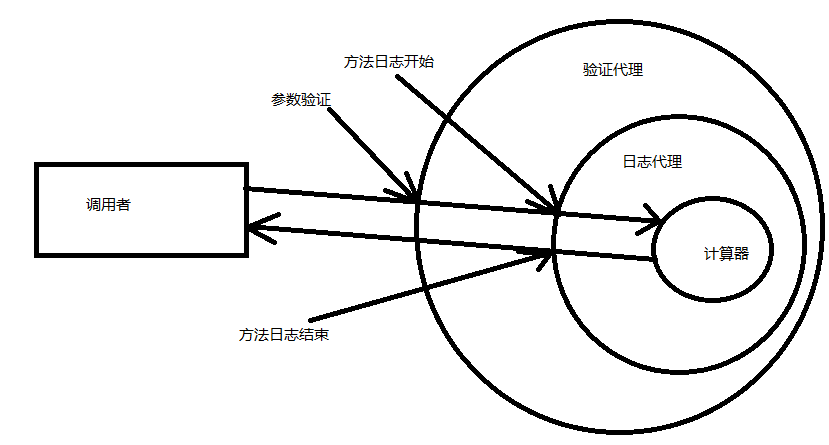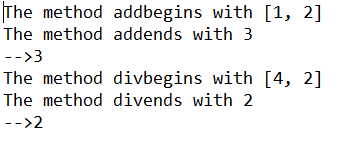【Why AOP ?】
1.代码混乱:越来越多的非业务需求(日志和验证等)加入后,原有的业务方法急剧膨胀。每个方法在处理核心逻辑的同时还必须兼顾其他多个关注点。
2.代码分散:以日志需求为例,知识为了满足这个单一需求,就不得不在多个模块(方法)里多次重复相同的日志代码。如果日志需求发生变化,必须修改所有模块。
示例:
ArithmeticCalculator.java:
1 package com.hk.spring.aop.helloworld; 2 3 public interface ArithmeticCalculator { 4 int add(int i,int j); 5 int sub(int i,int j); 6 int mul(int i,int j); 7 int div(int i,int j); 8 }
ArithmeticCalculatorImpl.java:
1 package com.hk.spring.aop.helloworld; 2 3 public class ArithmeticCalculatorImpl implements ArithmeticCalculator { 4 5 @Override 6 public int add(int i, int j) { 7 System.out.println("The method add begins with["+ i + "," + j +"]"); 8 int result = i + j; 9 System.out.println("The mathod add ends with " + result); 10 return result; 11 } 12 13 @Override 14 public int sub(int i, int j) { 15 System.out.println("The method sub begins with["+ i + "," + j +"]"); 16 int result = i - j; 17 System.out.println("The mathod sub ends with " + result); 18 return result; 19 } 20 21 @Override 22 public int mul(int i, int j) { 23 System.out.println("The method mul begins with["+ i + "," + j +"]"); 24 int result = i * j; 25 System.out.println("The mathod mul ends with " + result); 26 return result; 27 } 28 29 @Override 30 public int div(int i, int j) { 31 System.out.println("The method div begins with["+ i + "," + j +"]"); 32 int result = i / j; 33 System.out.println("The mathod div ends with " + result); 34 return result; 35 } 36 37 }
运行结果:

【使用动态代理解决上述问题】
1.代理设计模式的原理:使用一个代理对象将对象包装起来,然后用该代理对象取代原始对象。任何对原始对象的调用都要通过代理。代理对象决定是否以及何时将方法调用转到原始对象上。

ArithmeticCalculatorImpl.java:
1 package com.hk.spring.aop.helloworld; 2 3 public class ArithmeticCalculatorImpl implements ArithmeticCalculator { 4 5 @Override 6 public int add(int i, int j) { 7 int result = i + j; 8 return result; 9 } 10 11 @Override 12 public int sub(int i, int j) { 13 int result = i - j; 14 return result; 15 } 16 17 @Override 18 public int mul(int i, int j) { 19 int result = i * j; 20 return result; 21 } 22 23 @Override 24 public int div(int i, int j) { 25 int result = i / j; 26 return result; 27 } 28 29 }
ArithmeticCalculatorLoggingProxy.java:
1 package com.hk.spring.aop.helloworld; 2 3 import java.lang.reflect.InvocationHandler; 4 import java.lang.reflect.Method; 5 import java.lang.reflect.Proxy; 6 import java.util.Arrays; 7 8 public class ArithmeticCalculatorLoggingProxy { 9 //要代理的对象 10 private ArithmeticCalculator target; 11 12 public ArithmeticCalculatorLoggingProxy(ArithmeticCalculator target) { 13 this.target = target; 14 } 15 16 public ArithmeticCalculator getLoggingProxy(){ 17 ArithmeticCalculator proxy = null; 18 //代理对象由哪一个类加载器负责加载 19 ClassLoader loader = target.getClass().getClassLoader(); 20 //代理对象的类型,即其中有哪些方法 21 Class [] interfaces = new Class[]{ArithmeticCalculator.class}; 22 //当调用代理对象其中的方法时,该执行的代码 23 InvocationHandler h = new InvocationHandler() { 24 /** 25 *proxy:正在返回的那个代理对象,一般情况下,在invoke方法中都不使用该对象。 26 *method:正在被调用的方法 27 *args:调用方法时,传入的参数 28 */ 29 @Override 30 public Object invoke(Object proxy, Method method, Object[] args) throws Throwable { 31 String methodName = method.getName(); 32 //日志 33 System.out.println("The method " + methodName + "begins with " + Arrays.asList(args)); 34 //执行方法 35 Object result = method.invoke(target, args); 36 //日志 37 System.out.println("The method " + methodName + "ends with " + result); 38 return result; 39 } 40 }; 41 proxy = (ArithmeticCalculator) Proxy.newProxyInstance(loader, interfaces, h); 42 return proxy; 43 } 44 }
Main.java:
1 package com.hk.spring.aop.helloworld; 2 3 public class Main { 4 public static void main(String[] args) { 5 // ArithmeticCalculator arithmeticCalculator = null; 6 // arithmeticCalculator = new ArithmeticCalculatorImpl(); 7 8 ArithmeticCalculator target = new ArithmeticCalculatorImpl(); 9 ArithmeticCalculator proxy = new ArithmeticCalculatorLoggingProxy(target).getLoggingProxy(); 10 11 int result = proxy.add(1, 2); 12 System.out.println("-->"+result); 13 14 result = proxy.div(4, 2); 15 System.out.println("-->"+result); 16 } 17 18 }
运行结果:

【AOP简介】
1.AOP(Aspect-Oriented Programming,面向切面编程):是一种新的方法论,是对OOP(Object-Oriented Programming,面向对象编程)的补充。
2.AOP的主要编程对象是切面(aspect),而切面模块化横切关注点。
3.在应用AOP编程时,仍然需要定义公共功能,但可以明确地定义这个功能在哪里,以什么方式应用,并且不必修改受影响的类。这样一来横切关注点就被模块化到特殊的对象(切面)里。
4.AOP的好处:
--每个事物逻辑位于一个位置,代码不分散,便于维护和升级。
--业务模块更简洁,只包含核心业务代码。